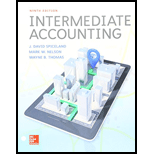
1.
Periodic Inventory System: It is a system in which the inventory is updated in the accounting records on a periodic basis such as at the end of each month, quarter or year. In other words, it is an accounting method which is used to determine the amount of inventory at the end of each accounting period.
First-in-First-Out (FIFO): In First-in-First-Out method, the cost of initial purchased items are sold first. The value of the ending inventory consists the recent purchased items.
Last-In, First-Out (LIFO): In Last-in-First-Out method, the cost of last purchased items are sold first. The value of the closing stock consists the initial purchased items.
Gross profit ratio is the financial ratio that shows the relationship between the gross profit and net sales. Gross profit is the difference between the total revenues and cost of goods sold. It is calculated by using the following formula:
To Compute: The gross profit and gross profit ratio for 2019.
1.
Explanation of Solution
Compute the gross profit and gross profit ratio.
| Gross Profit Ratio | |
| Details | Amount ($) |
| Net Sales (A) | 54,000,000 (1) |
| Less: Cost of Goods Sold | (27,000,000) (2) |
| Gross Profit (B) | 27,000,000 |
| Gross Profit Ratio (B ÷ A) | 50% |
Table (1)
Working Notes:
Compute the sales revenue.
Compute cost of goods sold.
Therefore, the gross profit and gross profit ratio is $27,000,000 and 50% respectively.
2.
To Compute: The gross profit and gross profit ratio for 2019 assuming 15,000 units are purchased during 2019.
2.
Explanation of Solution
Compute the gross profit and gross profit ratio.
| Gross Profit Ratio | |
| Details | Amount ($) |
| Net Sales (A) | 54,000,000 (1) |
| Less: Cost of Goods Sold (Refer Table 3) | (25,000,000) |
| Gross Profit (B) | 29,000,000 |
| Gross Profit Ratio (B ÷ A) | 53.7% |
Table (2)
Working Notes:
Compute the sales revenue.
Compute cost of goods sold.
| Calculation of Cost of Goods Sold | |||
| Details | Number of Units | Rate per Unit ($) | Total Cost ($) |
| 2019 | 15,000 | 1,000 | 15,000,000 |
| 2018 | 6,000 | 900 | 5,400,000 |
| 2018 | 4,000 | 800 | 3,200,000 |
| 2018 | 2,000 | 700 | 1,200,000 |
| Cost of Goods Sold | 27,000 | 25,000,000 | |
Table (3)
Therefore, the gross profit and gross profit ratio is $29,000,000 and 53.7% respectively.
3.
To Explain: The effects due to the decrease in inventory in gross profit and gross profit ratio using LIFO method.
3.
Explanation of Solution
C Incorporation has sold 27,000 units and purchased 15,000 units during 2019. When current sales are higher than current purchases during a period, LIFO liquidation occurs. It occurs when a company uses the Last in, First out (LIFO) method for inventory costing.
Hence, the gross profit computed in requirement 1 (Assuming the company purchased 28,000 units) is lower than requirement 2 (Assuming the company purchased 15,000 units).
Thus, in this case, the decrease in inventory quantity results in LIFO Liquidation Profit. If the company had purchased at least the number of units sold (27,000) during 2019, then there would no LIFO Liquidation. In this case, the LIFO Liquidation profit is $2,000,000 (Computed below) is material. Hence, C Incorporation must disclose it in a note.
Calculate the LIFO liquidation profit.
| LIFO Liquidation Profit | ||||
| Units Liquidated | Current Cost ($) | Acquisition Cost ($) | Difference between Current and Acquisition Cost ($) | Profit ($) |
| B | C | D | [C – D] | [B× E] |
| 6,000 | 1,000 | 900 | 100 | 600,000 |
| 4,000 | 1,000 | 800 | 200 | 800,000 |
| 2,000 | 1,000 | 700 | 300 | 600,000 |
| LIFO Liquidation Profit | 2,000,000 | |||
Table (4)
4.
To Compute: The gross profit and gross profit ratio for 2019 assuming C Incorporation used FIFO.
4.
Explanation of Solution
Compute the gross profit and gross profit ratio.
| Gross Profit Ratio | |
| Details | Amount ($) |
| Net Sales (A) | 54,000,000 (1) |
| Less: Cost of Goods Sold | (24,100,000) (3) |
| Gross Profit (B) | 29,900,000 |
| Gross Profit Ratio (B ÷ A) | 55.4% |
Table (5)
Working Note:
Compute cost of goods sold.
| Calculation of Cost of Goods Sold | |||
| Details | Number of Units | Rate per Unit ($) | Total Cost ($) |
| 2018 | 5,000 | 700 | 3,500,000 |
| 2018 | 4,000 | 800 | 3,200,000 |
| 2018 | 6,000 | 900 | 5,400,000 |
| 2019 | 12,000 | 1,000 | 12,000,000 |
| Cost of Goods Sold | 27,000 | 24,100,000 | |
Table (6)
Therefore, the gross profit and gross profit ratio is $29,900,000 and 55.4% respectively.
5.
To Explain: The effects due to the decrease in inventory in gross profit and gross profit ratio using FIFO method.
5.
Explanation of Solution
When FIFO method is used for inventory, then the number of units purchased has no effect on the cost of goods sold. This is because, in FIFO, at first the beginning inventory costs are included in the computation of cost of goods sold regardless of the inventory purchased during the current period.
Therefore, the gross profit computed assuming 28,000 units purchased during 2019 is same as it is computed assuming 15,000 units purchased during 2019.
Want to see more full solutions like this?
Chapter 8 Solutions
GEN COMBO LOOSELEAF INTERMEDIATE ACCOUNTING; CONNECT ACCESS CARD
- Compare and contrast the procedures for lodging an objection in Jamaica with those of Trinidad and Tobago.arrow_forwardThe actual cost of direct labor per hour is $16.25 and the standard cost of direct labor per hour is $15.00. The direct labor hours allowed per finished unit is 0.60 hours. During the current period, 4,500 units of finished goods were produced using 2,900 direct labor hours. How much is the direct labor rate variance? A. $3,625 favorable B. $3,625 unfavorable C. $4,350 favorable D. $4,350 unfavorablearrow_forwardOn January 1 of the current year, Piper Company issues a 4-year, non-interest-bearing note with a face value of $8,000 and receives $4,952 in exchange. The recording of the issuance of the note includes a: a. credit to Notes Payable for $4,952. b. credit to Discount on Notes Payable for $3,048. c. debit to Discount on Notes Payable for $3,048. d. debit to Cash for $8,000.arrow_forward
- During September, the assembly department completed 10,500 units of a product that had a standard materials cost of 3.0 square feet per unit at $2.40 per square foot. The actual materials purchased consisted of 22,000 square feet at $2.60 per square foot, for a total cost of $57,200. The actual material used during this period was 25,500 square feet. Compute the materials price variance and materials usage variance.arrow_forwardBluesy Electronics recorded the following financial data: Net Sales $720,500 Average Inventory at Cost = $80,200 Gross Margin Percentage = 42% Calculate the GMROI.arrow_forwardNeed help this question solutionarrow_forward
 Intermediate Accounting: Reporting And AnalysisAccountingISBN:9781337788281Author:James M. Wahlen, Jefferson P. Jones, Donald PagachPublisher:Cengage Learning
Intermediate Accounting: Reporting And AnalysisAccountingISBN:9781337788281Author:James M. Wahlen, Jefferson P. Jones, Donald PagachPublisher:Cengage Learning Financial Accounting: The Impact on Decision Make...AccountingISBN:9781305654174Author:Gary A. Porter, Curtis L. NortonPublisher:Cengage Learning
Financial Accounting: The Impact on Decision Make...AccountingISBN:9781305654174Author:Gary A. Porter, Curtis L. NortonPublisher:Cengage Learning Cornerstones of Financial AccountingAccountingISBN:9781337690881Author:Jay Rich, Jeff JonesPublisher:Cengage Learning
Cornerstones of Financial AccountingAccountingISBN:9781337690881Author:Jay Rich, Jeff JonesPublisher:Cengage Learning Financial AccountingAccountingISBN:9781337272124Author:Carl Warren, James M. Reeve, Jonathan DuchacPublisher:Cengage Learning
Financial AccountingAccountingISBN:9781337272124Author:Carl Warren, James M. Reeve, Jonathan DuchacPublisher:Cengage Learning



